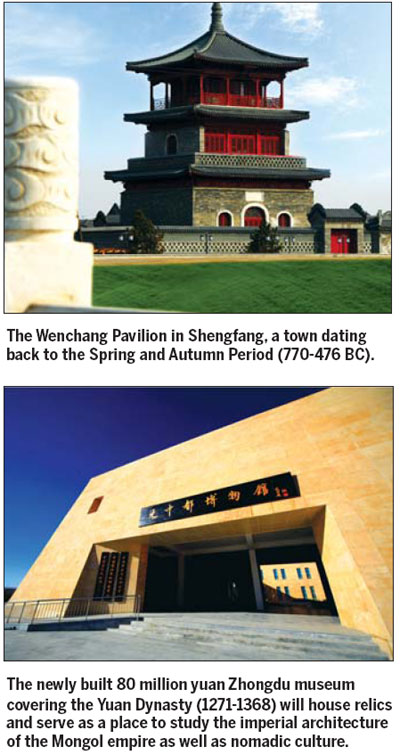
While Xanadu in Inner Mongolia, the summer capital of the Yuan Dynasty (1271-1368), was made a World Heritage site in June, conservation efforts are also underway for the remains of another of the dynasty's capitals.
Zhongdu, which literally means central capital, is 50 kilometers north of the county of Zhangbei in North China's Hebei province. Built in 1307 by Kublai Khan's grandson Qayisan, it was burned to the ground by rebelling farmers in an uprising half a century later.
Three of the 27 original sites in the ancient capital that was built in a three tiered layout are now protected, according to local heritage experts.
The local government has also begun building a museum about Zhongdu.
In addition to housing relics, the museum will also serve as a place to study the imperial architecture of the Mongol empire as well as nomadic culture, said Zhangbei government officials.
Archaeological excavations at Zhongdu started in 1998 and the ancient capital was listed among the country's 10 major archaeological discoveries in 1999.
It was one of three capitals the Yuan emperors established, the most important of which was Dadu, or great capital, which stood on the site of today's Beijing.
Shengfang ancient town
Encompassing Beijing and Tianjin, Hebei is rich in historical sites.
In addition to Zhongdu and the Chengde Summer Resort, other places of historical interest in the province include Shengfang in Bazhou city, said a tourism official at the provincial government.
Once a riverside town, Shengfang can trace its history to the Spring and Autumn Period (770-476 BC).
It rose as a trade center in North China in the late Qing Dynasty (1644-1911), attracting merchants from neighboring cities and provinces.
At its peak Shengfang had more than 400 stores, including a British store that sold Shell-brand oil, a local historian told China Daily.
It was among the first group of towns in China to have a post office and photo studio, he added.
Shengfang also has more than 30 Western-style buildings constructed in the early 20th century.
They are telling evidence how modern the ancient town once was, said a local tourism official.
The rare blend of Western and traditional Chinese architecture has helped attract visitors, the official said.
lifusheng@chinadaily.com.cn
(China Daily 07/27/2012 page24)
|